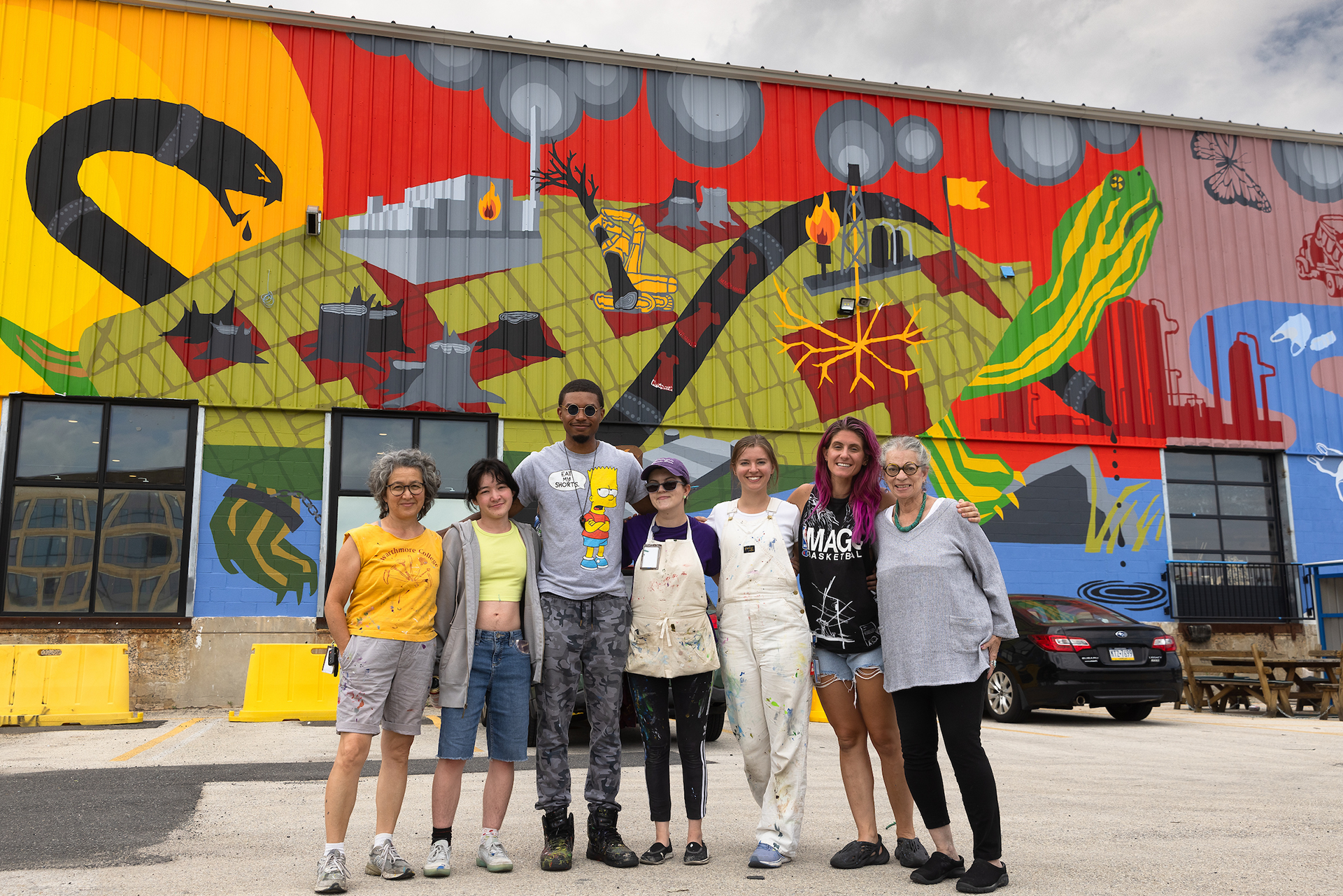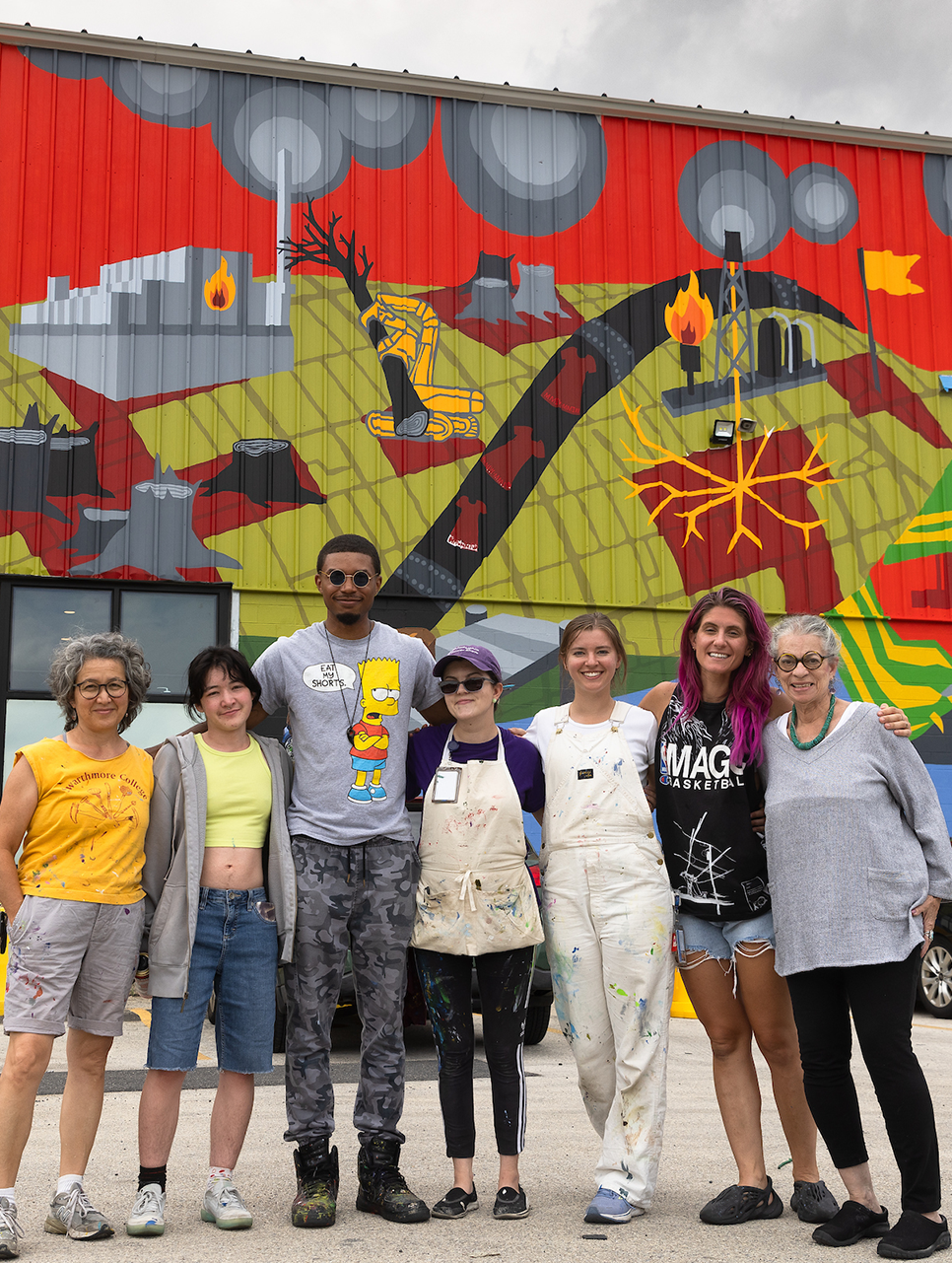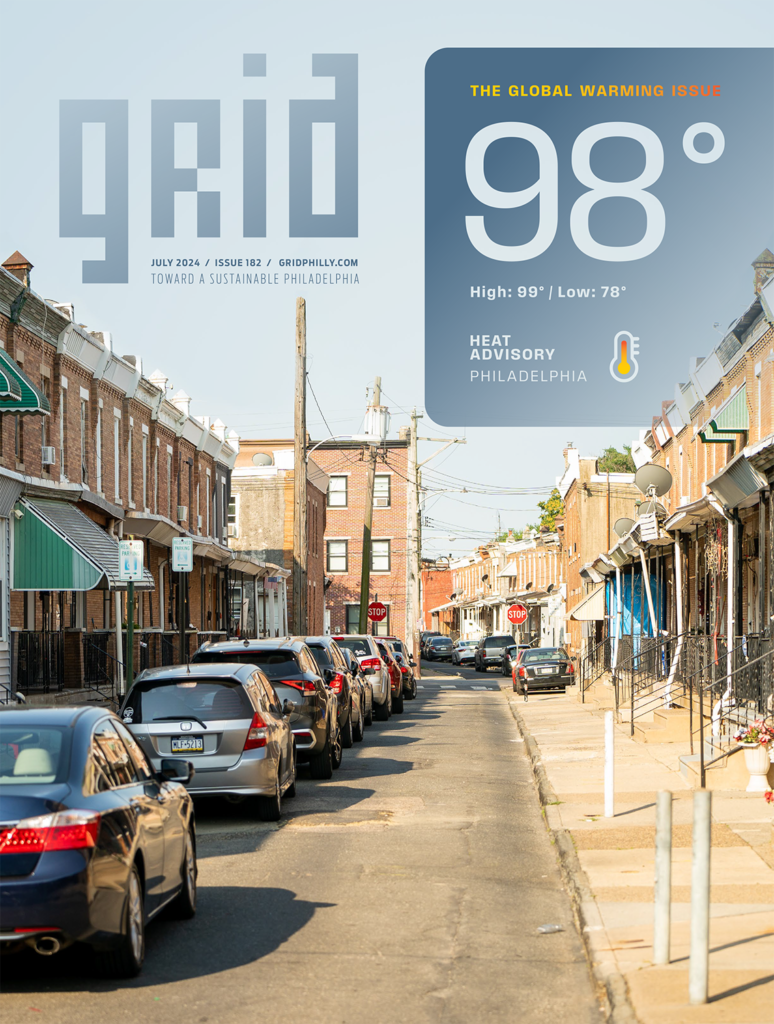For three days last summer, smoke drifted down from forest fires in the Canadian taiga, some of it shrouding 1800 North American Street, where volunteers were working on a climate justice mural.
Mirroring the dramatic depiction of oil spills, deforestation and smog being painted on the 300-foot long wall, the very real smoky orange haze and scorching temperatures caused the group to pause work for the health and safety of volunteers.

It wasn’t the only climate-related roadblock the project faced. “We had many 90-plus degree days where we couldn’t pull it off because there is no shade here,” says Eurhi Jones, an independent artist who helped design the mural.
The expansive, colorful depiction of our destructive past, present and hopeful future is the culmination of the years-long Climate Justice Initiative (CJI), spearheaded by Mural Arts Philadelphia.
We view art as powerful and transformative, but the challenge is to transcend the art and be able to galvanize individuals into collective action for climate justice.”
— Chad Eric Smith, Mural Arts Philadelphia
“Our focus is to create works of art that are accessible to the public but contribute to social impact in a positive way,” says Chad Eric Smith, senior director of communications and brand management at Mural Arts.
Smith says that while public art can draw attention to an issue and generate discussion, the challenge is moving the needle beyond discussing a beautiful image.
“We took a lot of energy and time to distill what can be viewed for some people as complex ideas, to be viewed as public art,” Smith says. “That’s why we view art as powerful and transformative, but the challenge is to transcend the art and be able to galvanize individuals into collective action for climate justice.”

The project relied heavily on education about climate change and the history of Indigenous peoples such as the Lenni-Lenape. Over 30 collaborators contributed their expertise on environmental justice successes and challenges through a series of teach-ins, community cleanups and the Art + Environmental Justice Symposium.
Jones; former design specialist for Mural Arts’ Environmental Justice Department Gamar Markarian; Nanticoke Lenni-Lenape artist Denise Bright Dove Ashton-Dunkley and Nanticoke artist Dolores Stanford were tasked with translating the findings from these educational discussions into an “epic image.”
Jones says the artists aimed to represent the frontline communities in Philadelphia who were invited into the creation process.

The mural depicts the Great Turtle emerging from a river, a reference to “Turtle Island,” a name used by some Native Americans for Earth or North America. Its shell is damaged by a factory, deforestation and fracking, while a snake-headed oil pipeline chokes it, referencing the Lakota prophecy that a black snake will destroy the people and the Earth. There are bloodied dresses referencing the Missing and Murdered Indigenous Women movement. Plastic bottles and oil pollute the waterways, while on a dock, a selling block and chains represent the commodification of people through chattel slavery.

In the next panel, a vibrant forest grows. Within its canopy are images of efforts to correct the environmental degradation through green jobs in solar energy, urban agriculture, the closing of oil refineries, expansion of public and cleaner transit options, and youth climate protests. Indigenous peoples are at the forefront, representing handing off knowledge to the next generation. In the final panel, a full moon shows a calendar based on Indigenous tradition, as well as monarch butterflies, inspiring hope for the future.

“With the climate movement worldwide, we have to look at Indigenous leadership and climate science leadership,” Jones says. “Especially Indigenous leadership about shifting our worldview if we’re to survive, and looking to the knowledge that already exists to care for the Earth that we’re given.”
The mural, installed on the building that houses businesses focused on sustainability such as NextFab and The Resource Exchange, was dedicated October 7, 2023, in celebration of Indigenous People’s Day.
Several workshops and events have been held at the site, including a deep dive on the Indigenous history and imagery depicted in the artwork and how to include Indigenous people in environmental justice work, led by Felicia Teter and Priscilla Bell Lamberty of Natives in Philly and artist Ashton-Dunkley.
Jonathan Leibovic, former organizer for Philly Thrive and a community liaison for CJI, hopes that special events can continue.
“I would love to see people using the site of the mural and associated space as a gathering place and a place to host all kinds of events about environmental justice,” says Leibovic.

Leibovic is writing a unit guide centered around the mural primarily for middle grade students called “Getting to the Roots.” It includes a scavenger hunt where people of any age can engage with the massive mural to identify its many symbols and learn about their meanings, ideally in person.
“In order to appreciate a mural, you have to physically be there. Looking at it online or on your phone doesn’t have the same effect,” Leibovic says. They hope to partner with teachers at schools, museums, environmental education centers and summer camps to use the materials starting this fall.
You can’t go to a different, better future if you don’t envision it first and I think artists help envision that possibility.”
— Eurhi Jones, independent artist
Jones believes that projects like this compel people to engage in issues they may not have otherwise.
“I found doing socially-engaged public art, that it is a place where people can come together, have fun, relax and be able to talk about issues that matter like this,” Jones says. “There’s room in the movement for joy, creativity and human connection. There’s not only room, they’re essential.”
Jones points to the presence and contributions of young people and artists in other social movements, and that artists’ inherent outside-the-box thinking is what the future needs.
“Everyone has to start thinking outside the stupid boxes we’re in [because] we’re not going to survive if we don’t start thinking differently,” Jones says. “You can’t go to a different, better future if you don’t envision it first and I think artists help envision that possibility.”










